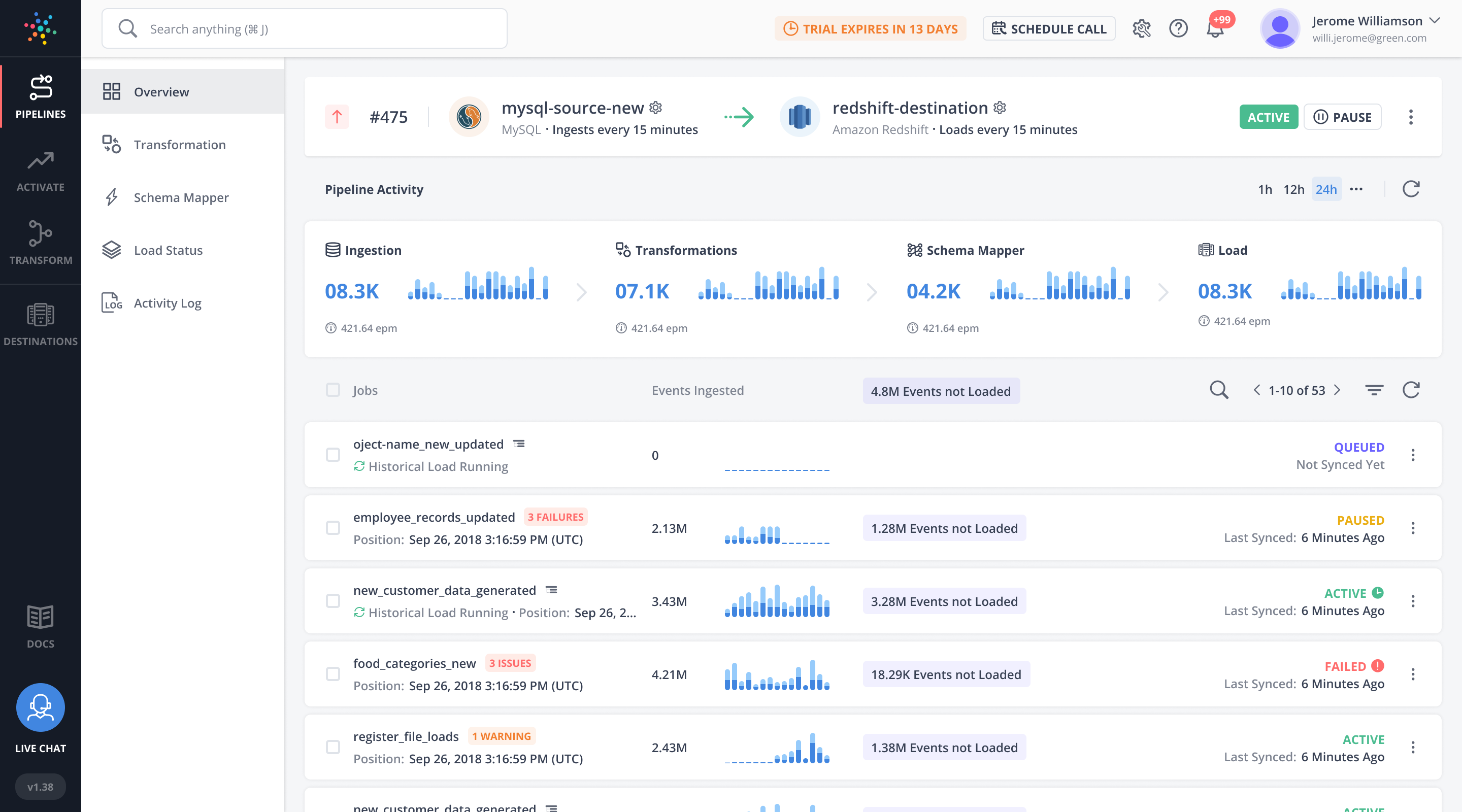Zero-code ETL tools – also known as no-code ETL tools – promise to help anyone create ETL (extract, transform, load) pipelines that drive success in today’s data-driven business environment. The following article reviews the pros and cons of using Hevo Data as a zero-code ETL platform.
Key points to note when evaluating zero-code ETL tools:
- A top-notch zero-code ETL tool should offer comprehensive monitoring and error-handling capabilities to help users identify and troubleshoot any issues during the data integration process.
- Zero code ETL tools need user-friendly interfaces that make data accessible to everyone for easy navigation and to perform data integration tasks without the need for coding or advanced technical skills.
- You'll want a platform that provides a wide range of pre-built connectors for seamless data extraction and integration across different platforms
- An efficient zero-code ETL tool should provide automation features that allow users to schedule and automate data extraction, transformation, and loading processes.
- The ETL tool should offer robust data transformation capabilities, allowing users to clean, filter, aggregate, and manipulate data as per their specific requirements.
Overall, a top-notch zero-code ETL tool should prioritize simplicity, ease of use, connectivity, data transformation capabilities, automation, and robust monitoring to enable non-technical users to efficiently integrate and manage data without extensive coding or technical expertise.
What Is Hevo Data?
Hevo Data is a zero-code ETL tool that makes it relatively easy for non-technical users to connect data sources to destinations. Hevo’s pipelines can reformat data before loading it to a destination, making it possible for business intelligence tools and other apps to find trends without producing errors.
Not sure whether Hevo Data has the features you want from a no-code ETL solution? Learn more about other options by reading Top 5 Hevo Alternatives.
Hevo Data Pricing
Hevo offers three pricing models.
Free
The Free plan comes with the data integration essentials you need to determine whether you want to invest in Hevo Data. It gives you access to:
- 50+ connectors to data sources, data warehouses, etc.
- One free initial load
- Unlimited models
- An unlimited number of users
- Customer support via email
Starter
If the free version looks appealing but doesn’t have all of the features your data team needs, you can upgrade to the Starter option. Starter membership pricing depends on how many events you use per month. Expect to pay:
- $239 per month for 5 million events
- $399 per month for 20 million events
- $750 per month for 50 million events
- $1,159 per month for 100 million events
A paid version of Hevo also gives you access to:
- 150+ connectors
- Free setup help
- 24x7 live chat support
- 12 hours support SLA (service level agreement)
- On-demand events
Business
A Business account with Hevo conforms to your unique needs, so you should contact the company for a custom quote. However, you can expect to get the following features on top of those available from the Starter membership:
- HIPAA compliance
- 6 hours support SLA (service level agreement)
- Access to a dedicated account manager
- Access to a dedicated data architect
Benefits of Using Hevo Data
Hevo Data has 4.3 out of 5 stars from reviewers on G2. Let’s see what people say about their positive experiences using Hevo Data.
User-Friendly Design
The people relying on zero code ETL tools for data extraction, data transformation, and data loading aren’t data scientists or computer programmers. More often than not, they’re marketing and sales professionals who need a simple user interface that makes data management as easy as possible.
Hevo Data has a user-friendly interface with straightforward dashboards and drag-and-drop features that makes the ETL process easy for people without data science or coding experience.
Change Data Capture (CDC)
Hevo Data supports change data capture (CDC), making it possible for users to track changes in data over time. You will typically use CDC during data replication. You don’t always want to create a copy of your entire database. With CDC, you only replicate the latest changes.
Often, CDC takes place in a SQL server. However, ETL platforms that support CDC give you advantages that make it easier to streamline workflows and discover trends as quickly as possible.
Learn more about the "Three Must-Know CDC Methods".
Reverse ETL
Reverse ETL transfers information from databases, data lakes, data warehouses, etc. to destinations like enterprise resource planning (ERP), customer relationship management (CRM), and BI tools. Data doesn’t offer many advantages when it sits in storage. Reverse ETL ensures you can move information into decision-making tools without hurting data quality.
Hevo Data supports reverse ETL, so you can build big data pipelines and make informed decisions without learning how to code.
What are the differences between ETL, ELT, and reverse ETL? Read "Reverse ETL – A Must-Have for Modern Business" for a deeper understanding.
Plug-and-Play Connectors
Hevo has a growing library of built-in connectors you can use to establish pipelines from data sources to data destinations. Some of the cloud storage destinations supported by Hevo’s native connectors include:
- Amazon Redshift
- Azure Synapse
- Google BigQuery
- MySQL
- PostgreSQL
With more than 150 connectors for data sources, it’s likely that Hevo’s data integration platform will make it easy for you to collect information from critical tools. The drag-and-drop interface lets you build data pipelines that pull information from sources like:
- Salesforce
- Google Drive
- Gitlab
- Amazon DocumentDB
- BigCommerce
You can also load data to business intelligence (BI) tools, helping you make data-driven decisions.
Disadvantages of Using Hevo Data
Overall, most people find that Hevo’s data transfer, data processing, and data integration solutions work well for non-technical users. All tools have room for improvement, though. Here are some of the most common complaints people discuss when reviewing Hevo Data.
You Can’t Edit Established Pipelines
The data pipeline that works well today might not meet your needs tomorrow. Maybe you want to add a new cloud data warehouse to your machine learning model, or your company recently switched to a different ecommerce platform.
Ideally, you could just edit established pipelines to reflect your evolving needs. With Hevo Data, you will need to start from scratch. You still benefit from its zero code ETL tool, but recreating pipelines – instead of just updating them – wastes time and interrupts real-time data flows.
Some Deleted Pipelines Manage to Hang Around
Since Hevo Data won’t let you edit established pipelines, you will need to delete old data ingestion methods that don’t match your needs anymore. Frustratingly, old pipelines have a way of hanging around. You might think you’ve removed a pipeline from your data integration tool only to find it saved somewhere on the platform.
Running into old pipelines gets confusing and can lead to mistakes. If you choose to rely on Hevo Data, make sure you give each pipeline a unique name. Otherwise, you might find yourself wondering whether you should use, for example, your Salesforce_Data_4 or Salesforce_Data4 pipeline. You wouldn’t have to wonder if you could delete old pipelines reliably.
Scheduling Jobs Gets Confusing
Zero code ETL tools potentially move large data volumes that can weigh on your network. For this reason, it often makes sense to schedule data migration during off hours. You don’t want to slow down employees during the day, but it probably won’t matter as much at night.
Scheduling and automation get tricky with Hevo Data, especially when working with data sources across time zones. Some people never figure out how to schedule jobs for specific times. That’s a big disadvantage in this zero-code ETL tool, supposedly designed for users without tech backgrounds.
How Integrate.io Can Help
Integrate.io offers many advantages that you won’t get from Hevo Data and similar zero-code ETL tools. In addition to ETL, reverse, ETL, and CDC, Integrate comes with API generation, data observability, and data warehouse insight features.
Native connectors let you interact with data from the most popular databases, cloud storage solutions, SaaS services, analytics tools, advertising platforms, and BI tools. If the library doesn’t include a connector you need, you can request one from the Integrate.io team. In the meantime, you can rely on flexible APIs that let your apps communicate with each other.
Are you ready for a no-code/low-code ETL tool that exceeds your expectations? Schedule a live demo to see how Integrate.io can help your teams get more out of the data they collect.












